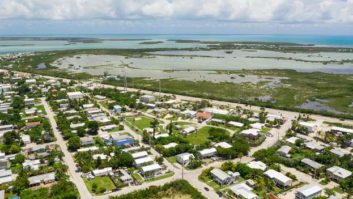The Federal Communications Commission has denied a request by CBS Radio to drop or reduce a $10,000 fine against WQYK(FM), St. Petersburg, Fla. for violating the maximum permitted exposure limits of the radio frequency radiation rules.
The station had asked the commission to review its Forfeiture Order, issued in 2007.
In the 1990s, the commission adopted new guidelines for evaluating the environmental effects of RFR from FCC-regulated transmitters. The maximum allowed exposure limits for electric and magnetic field strength power density for transmitters operating at frequencies from 300 kHz to 100 GHz.
Where there are multiple transmitters involved, all licensees share responsibility for bringing the area into compliance.
In response to a complaint in 2004, Tampa field agents inspected the Park Tower rooftop, a shared transmission site. Agents found a tower containing a UHF TV antenna for WVEA(LP), a second UHF-TV and two FM radio stations, one of which belonged to station WQYK(FM), then licensed to CBS Radio predecessor Infinity. All were on separate towers on the penthouse rooftop.
Agents said there were no RFR warning signs on the penthouse rooftop, and that approximately 75 percent of the penthouse rooftop exceeded the general population/uncontrolled RFR maximum permissible exposure limit. The agents went back twice more and found the same conditions.
On a third inspection agents found that Entravision, one of the four licensees on the site, posted warning RFR signs in the stairway but not on the roof itself. When station WVEA(LP) was taken off the air, the agents determined that WVEA was responsible for most of the uncontrolled RFR emissions and WQYK for more than 5 percent.
Agents told the WQYK engineer that despite the signs and yellow paint used by WVEA(LP) to mark the areas on the rooftop that exceeded RFR exposure limits, the area was still not properly marked. The agents also suggested that the station WQYK engineer speak with the building’s chief engineer to discuss other steps to give the workers knowledge and control over their exposure.
After two more inspections, the agents still found RFR limits were too much and warning signage on the roof was inadequate. WVEA(LP) placed a sign on its tower that cautioned workers that the yellow striped area exceeds safe occupational levels. The sign, however, did not list any station contact information to help workers find out the level of the RFR on the penthouse rooftop.
In late 2004, the building’s chief engineer contacted the FCC’s Tampa Office and stated that station WVEA(LP) told him that the transmitter power had been reduced and the rooftop was now well below the occupational limit. Agents confirmed that with measurements but said RFR emissions were still well above the general population/uncontrolled limit.
In January of 2005, the Tampa Office issued a $20,000 fine to WQYK for failing to comply with RFR MPE limits on the penthouse rooftop of Park Tower. Infinity asked that the fine be rescinded. While not disputing the RFR measurements, Infinity argued that the occupational/controlled RFR MPE limit should have been applied to the penthouse roof rather than the public/uncontrolled RFR MPE limits.
In early 2007, the FCC fined Infinity $10,000 for failing to comply with RFR MPE limits applicable to facilities, operations or transmitters. The FCC said the workers accessing the rooftop weren’t aware of the potentially high RFR because the markings were inadequate. “[T]he one and only RFR sign leading to the penthouse rooftop was routinely hidden from view of those accessing the penthouse roof because the door was routinely open,” said the agency in its decision this week. On each of their six inspections, FCC agents didn’t see the sign, they said.
As a licensee contributing more than 5% of its transmitter’s RFR MPE limit, Infinity was obligated to ensure RFR awareness and control for the affected workers and employees, not the Park Tower building management, said the commission. It did agree that the base fine had been raised and agreed to drop that back to $10,000.
Infinity then asked the commission to review its decision, asserting that strict liability for licensees contributing 5% to an RFR field in excess of the MPE is unreasonable when a licensee is unaware a violation exists. That didn’t fly; the FCC pointed out that in its renewal application for WQYK, Infinity stated that areas on the penthouse rooftop where the station is located exceed the commission’s MPE limits for controlled environments and that the areas are clearly identified and marked. Infinity had also stated that access to the transmitting site is restricted and properly marked with warning signs and thereby classified as a controlled environment.
The FCC found no merit to Infinity’s argument that there is no equipment to maintain on the rooftop for the building engineer and his crew and therefore they don’t go up on the roof and were not exposed to RFR. It also refuted an argument by Infinity that the station engineer was confused when talking to the FCC inspector about RFR overexposure and actually referring to an incident that occurred in 2003.
Infinity’s application for review was denied and the $10,000 payment to the FCC is due within 30 days.
Read the case here.








